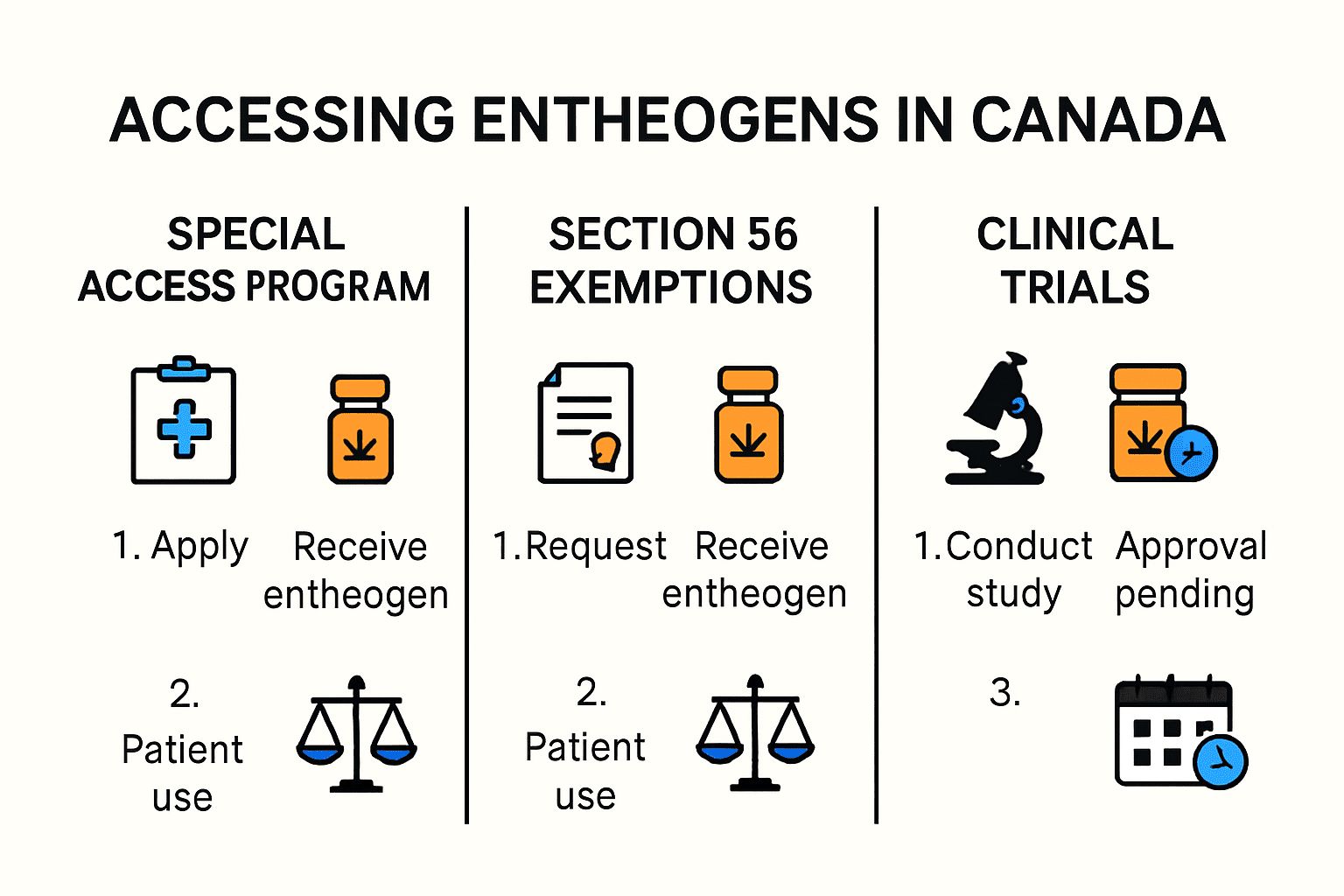Entheogens have shaped spiritual practices and mental health treatments for centuries, yet they remain one of the least understood classes of psychoactive substances. Modern science now shows that entheogens can rapidly relieve stubborn depression and anxiety where traditional medicine fails. Most people think these are just risky recreational drugs, but the truth is that in Canada, there are clear legal paths for patients and doctors to safely access these powerful healing tools.
Table of Contents
- Defining Entheogens: Nature And Characteristics
- The Historical Importance Of Entheogens In Cultures
- The Science Behind Entheogens: How They Affect The Brain
- Applications Of Entheogens In Mental Health And Wellness
- Legal Status And Access To Entheogens In Canada
Quick Summary
| Takeaway | Explanation |
|---|---|
| Entheogens enhance spiritual consciousness. | These substances are utilized to facilitate introspective experiences and profound spiritual insights beyond ordinary perceptions. |
| Entheogens have therapeutic potential. | Research indicates they can effectively treat conditions like depression, anxiety, and PTSD, offering new avenues for mental health treatments. |
| Legal frameworks in Canada support entheogen access. | Canada has established pathways for patients to access entheogens, balancing scientific research with therapeutic applications. |
| Entheogens were integral to ancient rituals. | Indigenous cultures have historically used entheogens in spiritual practices, emphasizing their role in community well-being and healing. |
| Neurochemical changes influence perception. | Entheogens interact with serotonin receptors, altering brain function and consciousness, and offering insights into mental processes. |
Defining Entheogens: Nature and Characteristics
Entheogens represent a fascinating category of psychoactive substances that transcend traditional definitions of drugs or medications. Exploring spiritual consciousness reveals these unique compounds as powerful tools for transforming human perception and understanding.
The Etymological Roots of Entheogens
The term “entheogen” emerges from ancient Greek linguistic roots, combining “entheos” (meaning “divine within”) and “genesthai” (meaning “to generate”). This etymological foundation highlights the profound spiritual and transformative potential inherent in these substances. Entheogens are not merely chemical compounds but sacred conduits designed to facilitate extraordinary states of consciousness.
Characteristics of Entheogens
Entheogens possess distinctive qualities that separate them from recreational drugs or traditional pharmaceuticals. These substances share several key characteristics:
- Induce non-ordinary states of consciousness
- Facilitate deep introspective experiences
- Frequently used in religious and spiritual contexts
- Potentially trigger mystical or transcendent perceptions
While many substances can be classified as entheogens, they typically originate from natural sources like plants, fungi, and botanical extracts. Psilocybin mushrooms, ayahuasca, peyote, and certain cacti represent prominent examples of these remarkable compounds.
Below is a table highlighting the key characteristics that distinguish entheogens from other types of psychoactive substances. This overview helps clarify their unique roles and features.
| Characteristic | Description |
|---|---|
| Induce non-ordinary consciousness | Entheogens provoke altered states distinct from normal waking perception and awareness. |
| Facilitate introspective experiences | They enable deep self-reflection and personal insight. |
| Used in religious/spiritual contexts | Traditionally employed in ceremonies, rituals, and spiritual practices. |
| Trigger mystical perceptions | Users often report experiences of transcendence or connection beyond the self. |
| Natural origins | Most are derived from plants, fungi, or botanical extracts. |
| Seen as tools for personal growth | Regarded as catalysts for psychological and spiritual transformation, not simple recreation. |
Understanding entheogens requires recognizing their fundamental purpose: not for recreational escape, but as potential catalysts for personal insight, spiritual exploration, and psychological transformation. Our guide on microdosing protocols offers deeper insights into responsible and intentional use of these profound substances.
The Historical Importance of Entheogens in Cultures
Throughout human history, entheogens have played a profound and transformative role in cultural and spiritual practices across diverse civilizations. Insights from indigenous research reveal these substances as more than mere chemical compounds, but as sacred tools for understanding consciousness and connecting with spiritual realms.
Ancient Spiritual Practices
Indigenous cultures worldwide have long recognized entheogens as powerful conduits for spiritual experiences. From the Mazatec shamans of Mexico using psilocybin mushrooms to the Amazon basin tribes utilizing ayahuasca, these substances were integral to religious rituals, healing ceremonies, and community transformation. Spiritual leaders would carefully administer these substances during critical moments like coming-of-age ceremonies, conflict resolution, and communicating with ancestral spirits.
Cultural Transmission and Wisdom
Entheogens served multiple critical functions in traditional societies:
- Facilitating communication with spiritual dimensions
- Providing collective healing experiences
- Transmitting cultural knowledge and oral traditions
- Supporting psychological and emotional growth
These substances were not recreational tools but sacred technologies for understanding human experience and maintaining social cohesion. Elaborate ritualistic protocols surrounded their use, ensuring safe and meaningful experiences that contributed to community well-being.
Global Spiritual Traditions
Different cultures developed unique approaches to entheogen usage. Native American Church ceremonies incorporated peyote as a sacramental substance, while Andean cultures used San Pedro cactus in high-altitude spiritual practices. In Amazonian traditions, ayahuasca became a cornerstone of shamanic healing and ecological understanding. Learn more about traditional mushroom practices that highlight the deep cultural significance of these remarkable substances.
The Science Behind Entheogens: How They Affect the Brain
Entheogens represent a complex neurological phenomenon that fundamentally transforms brain function and perception. Groundbreaking research in neuropharmacology reveals these substances as powerful modulators of neural connectivity and consciousness.
Neurochemical Interactions
At the molecular level, entheogens primarily interact with serotonin receptors, specifically the 5-HT2A receptor sites. Profound neurological changes occur when these compounds bind to brain receptors, triggering cascading effects that dramatically alter sensory processing, emotional regulation, and cognitive flexibility. This interaction creates a unique neurochemical environment where typical brain communication patterns are temporarily disrupted, allowing for novel neural connections and expanded perceptual experiences.
Key Neurological Mechanisms
Entheogens induce remarkable brain changes through several critical mechanisms:
- Temporarily reducing default mode network activity
- Increasing neural plasticity and connectivity
- Disrupting standard information processing patterns
- Enhancing brain network communication
These neurological shifts can potentially reset entrenched psychological patterns, offering therapeutic potential for conditions like depression, anxiety, and trauma-related disorders. Brain imaging studies have demonstrated how these substances can create temporary but significant changes in brain organization and function.
Consciousness and Perception Transformation
Beyond biochemical interactions, entheogens fundamentally challenge our understanding of consciousness. They demonstrate how neurochemical changes can profoundly alter subjective experience, suggesting consciousness is more fluid and malleable than traditional scientific models propose. Discover more about brain health innovations that explore these fascinating neurological frontiers.
Applications of Entheogens in Mental Health and Wellness
Entheogens represent a groundbreaking frontier in mental health treatment, offering innovative approaches to addressing complex psychological challenges. Pioneering clinical research demonstrates their profound potential for transforming mental wellness strategies.
Therapeutic Potential for Mental Health Disorders
Emerging scientific evidence suggests entheogens can provide rapid and substantial relief for treatment-resistant mental health conditions. Clinical trials have shown remarkable outcomes in addressing depression, anxiety, post-traumatic stress disorder, and addiction. Unlike traditional pharmaceutical interventions, these substances appear capable of creating fundamental shifts in psychological processing, enabling patients to break through long-standing emotional barriers.
Key Mental Health Applications
Entheogens show promising therapeutic applications across multiple domains:
- Treating major depressive disorders
- Reducing anxiety and existential distress
- Supporting addiction recovery processes
- Facilitating trauma resolution
- Enhancing emotional regulation
The therapeutic mechanism extends beyond symptom management, potentially addressing root psychological patterns. Neuroplasticity induced by these substances allows individuals to reconstruct deeply ingrained emotional and cognitive frameworks, offering a more holistic approach to mental wellness.
Comprehensive Wellness and Personal Growth
Beyond clinical treatments, entheogens are increasingly recognized as tools for personal transformation and psychological exploration. They provide unique opportunities for deep introspection, helping individuals gain profound insights into their emotional landscapes and spiritual dimensions. Explore comprehensive wellness strategies that integrate these remarkable substances into holistic mental health approaches, highlighting their potential to support comprehensive human development and psychological resilience.

Legal Status and Access to Entheogens in Canada
Canada represents a pioneering jurisdiction in recognizing the therapeutic potential of entheogens, implementing progressive legal frameworks that balance scientific research with patient access. Comprehensive regulatory research reveals nuanced pathways for legal entheogen utilization.
Regulatory Frameworks for Access
Canadian health authorities have established multiple legal mechanisms for entheogen access, prioritizing patient safety and medical innovation. The primary pathways include the Special Access Program (SAP), Section 56(1) exemptions, and regulated clinical trials. These frameworks allow healthcare professionals and patients with serious or treatment-resistant conditions to explore entheogens as potential therapeutic interventions.
Legal Access Mechanisms
Canada offers several structured approaches for legal entheogen access:
- Special Access Program (SAP) for healthcare practitioners
- Section 56(1) exemptions for individual medical use
- Regulated clinical trial participation
- Compassionate access for end-of-life and palliative care patients
- Research and training exemptions for medical professionals
Each pathway requires rigorous medical documentation, professional oversight, and demonstrated medical necessity. Regulatory compliance remains crucial, with Health Canada maintaining strict guidelines to ensure patient safety and responsible usage.
The following table summarizes the main legal pathways through which patients and healthcare professionals can access entheogens in Canada. Understanding these mechanisms helps clarify how entheogens are regulated for safe and therapeutic use.
| Access Mechanism | Who Qualifies | Purpose / Conditions |
|---|---|---|
| Special Access Program (SAP) | Healthcare practitioners | For critical or treatment-resistant cases |
| Section 56(1) Exemptions | Individual patients | Medical use, with physician support |
| Regulated Clinical Trials | Study participants | Participation in approved research studies |
| Compassionate Access | Palliative/end-of-life care | For severe illness where other treatments failed |
| Research/Training Exemptions | Medical professionals | For specific educational or research purposes |
Future Regulatory Landscape
The Canadian approach to entheogens signals a progressive understanding of alternative medical treatments. Ongoing research and evolving legal frameworks suggest a potential expansion of access and recognition of these substances’ therapeutic potential.

Explore the latest legal considerations to stay informed about this rapidly developing field of medical innovation and regulatory adaptation.
Ready to Experience the Transformative Power of Entheogens Safely?
Many people who read about entheogens are searching for meaningful ways to enhance mental clarity, support emotional balance, or break free from cycles of anxiety and stress. If you feel overwhelmed by the information on legality, dosing, and safe use in Canada, you are not alone. At Kind Stranger, we understand how the insights from science and tradition can be hard to put into practice without trustworthy support. Our focus on microdosed psilocybin answers the need for gentle, approachable wellness tools that align with harm-reduction and self-discovery.

You can begin exploring the benefits of plant-based mental wellness today. Visit Kind Stranger to discover our selection of microdosed products designed for daily clarity and mood support. Learn about microdosing protocols and legal considerations in Canada through our trusted resources. Take your next step toward a more balanced, focused mind now and join a supportive community that empowers responsible, intentional journeys.
Frequently Asked Questions
What are entheogens?
Entheogens are psychoactive substances that facilitate spiritual or mystical experiences, often derived from natural sources such as plants and fungi. They are intended for personal insight and transformation rather than recreational use.
How do entheogens affect the brain?
Entheogens primarily interact with serotonin receptors, particularly the 5-HT2A receptor. This interaction leads to enhanced neural connectivity and altered sensory processing, which can transform consciousness and perception.
What are some common examples of entheogens?
Common examples of entheogens include psilocybin mushrooms, ayahuasca, peyote, and specific cacti. These substances have been used in various cultural and spiritual contexts for centuries.
What is the therapeutic potential of entheogens for mental health?
Entheogens show promise in treating mental health disorders such as depression, anxiety, PTSD, and addiction. They can help facilitate emotional breakthroughs and foster neuroplasticity, enabling patients to address underlying psychological issues.
Recommended
- The History of Psilocybin Mushrooms: From Tradition to Modern Wellness • KIND STRANGER
- Psilocybin and Spirituality: Exploring Benefits in 2025 • KIND STRANGER
- Can You Travel With Psilocybin? Laws, Risks, and Safe Options • KIND STRANGER
- Exploring Psychedelics for Mental Health Benefits • KIND STRANGER


Comments
There are no comments yet.